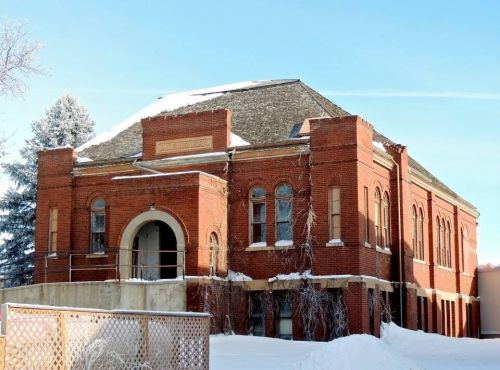Last Word | May 23rd, 2018

By Ken Smith
kelandsmith@gmail.com
When the State of North Dakota decided to sell the campus of the Ellendale Branch of the University of North Dakota following the disastrous January 1970 fire that destroyed the two main buildings, the town prepared a big color glossy brochure to attract potential buyers of the campus. That brochure listed every single building, and evaluated their condition. The Armory (built in 1905) ranked lowest on the list in terms of its condition. It was the only building that had the recommendation "replace" next to it. But when Trinity Bible Institute moved onto the campus in 1972, the armory became the chapel for a large student body. Several years later a new chapel was erected, but the armory continued to serve as classroom and office space for nearly four decades.
Ellendale and the state of North Dakota are fortunate that this 113 year-old building has been preserved, and at this very moment is being restored and refurbished. When Paul Alexander, a native of South Africa and longtime missionary educator in Great Britain, assumed the presidency in 2013, he made preserving and restoring the two oldest buildings a very high priority. The perseverance has paid off. This September there will be a celebration during which this building--the oldest on the campus--and Davidson Hall (formerly Dacotah Hall Women's Dorm, the second oldest building on campus, dating to 1907) will be presented to the public. In addition, the restored President’s house, constructed in 1905-1906 by attorney and prominent North Dakota Democratic politician Hector Perry, will be on display. The refurbishments of all these buildings are very thorough and professional and up-to-date with all building standards, and are beautifully finished inside. Saving and refurbishing these structures is an accomplishment that deserves notice around the state and region. It hasn't been cheap or easy, but this good work deserves recognition far and wide.
Preserving the Armory at Ellendale is noteworthy for several reasons, but to me the moniker above the west entrance, which reads “M.T.S. ARMORY” is primary. The building has served as college militia headquarters, gymnasium, dance hall, auditorium for concerts and plays, chapel, classrooms, science lab, dorm rooms & offices (in the basement), and much more. It's the oldest building remaining on campus, and has a certain chunky stateliness. And it’s a gateway to history. So is Davidson Hall.
When the Manual Training School began operating in 1899--ten years after its existence was assured by inclusion in the North Dakota Constitution--its founders had a very specific vision in mind. Since the mid 19th century, a broad-based educational reform movement had been urging public schools everywhere to incorporate manual work—handcrafts such as woodwork, metalwork, drawing, dressmaking, carpentry, scientific cooking and more—as a means of broadening the education of their students. Those who would teach these manual arts needed training, and that’s what the school at Ellendale was founded to do. The school worked hard to do it without watering down the bookish element. Latin and German were taught alongside manual arts courses. Ina Randall, a member of the first graduating class in 1901, gave as her valedictory oration an elegant defense of the philosophy of manual training. Miss Randall’s speech, which carefully balances artistic values with pragmatic concerns, can be read in full at www.bit.ly/mts1901.
Many commentators have noted that the impulse to save old buildings runs stronger in the European mind than the American mind. If so, this may be illustrated by the fact that during the same year Ellendale’s oldest college buildings are entering a renaissance, some of the oldest on the UND campus in Grand Forks are meeting their demise. For myself, a UND alumni (M.A. 1998, D.A. 2001), the contrast is particularly clear. When I first became interested in the history of the state’s flagship university, one of the obvious pulls was the fact that the “Wesley College” moniker was branded indelibly on the front of the building I walked past nearly every day. It hinted of a history that had largely slipped out of view. It helped inspire both my thesis and dissertation--biographies of UND’s first president and first dean of education respectively—both of which dealt with the theme of the interplay between religion and higher education. Now that this moniker is being knocked down, I wonder if this history will vanish even deeper beneath the relentless waves of time.
In considering this loss, I can’t help but thinking about the permanence of the destruction that is about to take place. In his 1941 poem “The Covered Bridge,” the poet Anderson Scruggs, saddened at the loss of covered bridges, lamented that “some part of life becomes oblivion; something with roots buried deep in the heart; of simple folks is lost, as one by one; these pioneers of other days depart.” Scruggs closes his poem with a reminder of human agency: “yet there are soulless men whose hand and brain; tear down what time will never give again.” The poem suggests that tearing down landmarks is a conscious deliberate act, not one that’s predetermined by some imagined necessity. And it’s devastatingly permanent. I became aware of the poem from the latter lines that are inscribed on a sign hung over an enormous, elegant Corliss 1904 steam engine from a Wisconsin box factory that was lovingly and patiently restored by enthusiasts of the Western Minnesota Steam Threshers Reunion at Rollag. Watching the engine in quiet, graceful motion, and seeing the sign hung above it, never fails to bring a tear to my eye. Tearing down is easy. Preservation and restoration is a work of love and passion as well as of hand and brain. I can only wish for a resurgence of this love and passion among those who chart out the future of our institutions.
One irony, probably one among many, is that our state’s leading secular university is about to demolish a set of buildings that were once devoted to a religious purpose. Here in Ellendale our religiously based college is about to finish restoring a pair of buildings that were once devoted to a secular purpose. Religious motivations aside, we seem to live in an age when pragmatically-oriented, bottom-line economic preoccupations are automatically given precedence over ideas and over history. That’s a problem for any institution that purports to be a haven for the mind and for passing on the intangible legacies bequeathed by the past. Preserving these legacies is particularly important in our present day, and preserving tangible gateways to them deserves to be high on any list of priorities.
Those interested in the history of the college at Ellendale are invited to examine the school’s yearbooks, which began in 1912. All of them are accessible in full at archive.org, using the keyword “Snitcher.” Various other items related to Ellendale’s college, high school, and miscellaneous local history topics can also be found in the “cliosmith” collection at archive.org
[Editor’s note: Ken Smith is President of the Ellendale Historical Society and curator of the Coleman Museum in Ellendale.]
November 18th 2025
September 23rd 2025
June 19th 2025
June 19th 2025
April 27th 2025
__293px-wide.jpg)
_(1)__293px-wide.png)


_(1)__293px-wide.png)
